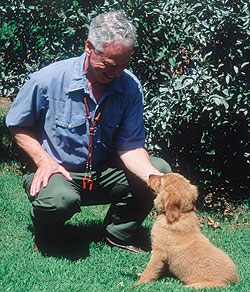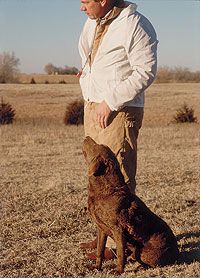Save a lot of time and headaches by mastering this ever-important command.
By James B. Spencer
 Teaching a retriever puppy to sit is quite simple, in fact, too simple. Grown retrievers would sit more reliably if this early training were more difficult, and took more time and effort. |
Of the three parts of the blind retrieve (lining, stopping, casting) near-perfection is sine qua non (which any ancient Roman kid knew means "without which there is nothing") only for stopping.
You can pick up most of the birds your retriever doesn't mark if he stops reliably, even if he's a little loose in his lining and occasionally careless in his casting. His work won't always be pretty, and he'll seldom send hunt test and field trial judges into rapture, but he'll consistently recover the birds you shoot while hunting.
Years ago, Jigger, an easily-distracted pointer, convinced me of this. Please understand: Jigger never did a blind retrieve in his life. In fact, he resented, sometimes even disdained, ordinary retrieving, even after I force-broke him. So how did he convince me of this? You see, if he was more than 50 yards away -- and he was seldom that close while hunting -- he had great difficulty remembering what "Come" meant long enough to get all the way back to me.
His heart was in the right place, but being a bit of an airhead, he'd veer off again and again along the way. In frustration and despair, I drilled him intensely on "Whoa." Surprisingly, he took so well to this and became so reliable at it that, even at great distances, he would stand there for a long time. He was great at standing still, but he couldn't handle moving.
Eventually, I bowed to Jigger's superior judgment and ceased even trying to call him to me.
Instead, I whoa-ed him, walked out, snapped a lead on him, and heeled him to wherever I wanted him to be. It worked; it gave me some extra exercise; and, frankly, it saved a lot of time.
 Extending the on-lead training to the field. |
That's how reliable stopping became a part of my belief system long before I started teaching retrievers to do blind retrieves.
Among retrieverites, the verbal stop command is "Sit," but this is seldom used except for small puppies. Instead, we use the "Sit-whistle," which by both tradition and common sense is a single sharp whistle blast, TWEEEET! When you want your retriever to stop, you usually want him to do so right there and right now. Thus you don't have time to play him a tune on your whistle.
Sometimes, when he's flying off in the wrong direction, you'll feel a little pressed for time even with TWEEEET!
Now here's a confession of a Sit-whistle addict: Because I've always stressed stopping much more than I have lining or casting, both afield and in dog-games my retrievers have perpetrated many "PILs" (poor initial lines), and many cast refusals, some major, some minor. But I can't remember ever experiencing a "slipped whistle," (a popular ego-saving euphemism for "whistle refusal"), in either hunting or dog-games.
Clearly, I'm a nut-case on the Sit-whistle, so keep that in mind as you read the following comments thereto appertaining.
 The "automatic sit" is necessary also in field work, when setting a retriever up at the line. |
The Problem
Perhaps the main reason so many retrieverites suffer not infrequent slipped whistles, whether under judgment or in hunting, is that retriever puppies learn so quickly and easily to sit on both the vocal command, Sit, and the Sit-whistle. Most puppies pick this up after only a few sessions.
The inexperienced owner, exhilarated at his new-found genius in dog training, pats himself on the back and moves on to the next command, unwilling to bore either his puppy or himself any longer with that sooo-simple Sit command.
Later, in blind retrieves, the youngster obeys the Sit-whistle when he has nothing better to do, but otherwise ignores it. The embarrassed owner does the worst possible thing: He repeats the Sit-whistle, again and again if necessary, until the pup does eventually sit. With "success" at last, the owner blithely ignores the clear evidence that he has turned the Sit-whistle into an option, rather than a command, for his dog.
That's why, in both hunting and dog-games, so many retrievers go out of control on blind retrieves. No dog goes completely out of control with poor lining or casting, as long as said dog will stop reliably (i.e., almost every time). Too many PILs or cast refusals will cause dog-game judges to drop a dog, but only repeated slipped whistles will send the beast completely out of control.
The Solution
The solution lies completely in the mind and attitude of the trainer. Sure, teaching a puppy to sit is easy. But instead of becoming bored, the trainer should become increasingly more grateful to those wonderful people who developed our retriever breeds for giving us dogs that take so quickly and easily to this so important blind retrieve command. Isn't it nice to have the important stuff come so easily to our dogs?
The trainer should also reflect frequently on the fact that, for canines as well as humans, the "use it or lose it" rule applies. Thus, just as successful human athletes frequently practice the basic skills of their respective sports, dogs must be drilled frequently on the basic skills of their specific lines of work.
For retrievers, marking and the three parts of the blind retrieve fall into that category of "basic skills." Working on marking, lining, and casting is challenging and exciting, whereas working on stopping is something less than thrill-a-minute training for most retrieverites. Nevertheless, it is extremely important to overall success.
Ongoing Training
Once your puppy has learned to sit on the Sit-whistle in the backyard, he's ready for distractions that will tempt him to ignore the whistle. Start out in the backyard, and keep him on lead so you can control him. Toot the Sit-whistle and after he sits, have a friend or family member suddenly appear and walk t
oward him.
If your puppy, predictably, breaks and starts toward that person, jerk him back into place with the lead, and make him sit again. As soon as he's again sitting correctly, praise him. You just corrected him for "disobeying," so simple justice demands that you reward him now that he's again obeying, even under duress, in fact, especially because he's under duress.
 The romp-drill described in this column, here with two retrievers. |
Introduce other distractions this way in the backyard until he's absolutely reliable. Then, take him to various public places, where he will experience a variety of unfamiliar distractions, and work him on the Sit-whistle (and other commands). If you use your imagination, you'll come up with any number of ways to introduce distractions.
Out in the field, after each training session, snap a retractable lead on him and take him for a romp. Let him run around as he likes, and then toot the Sit-whistle every five or 10 minutes (no more often, please). If he sits, praise and release him. If he doesn't, correct him with the retractable lead, and then praise him.
Ideally, when he's six or seven months old, you will "collar-condition" him to the e-collar, for this will give you control at any practical distance. If you've never collar-conditioned a dog before, you should seek the guidance of a reputable pro or experienced amateur trainer. (Or follow the instructions in the Appendix of either of the following books: Retriever Training Drills for Blind Retrieves or Retriever Training Drills for Marking, which you can find in the Gun Dog Bookshelf.)
After your youngster has been collar-conditioned, you can dispense with the retractable lead in these post-training romps and teach him to obey the Sit-whistle at much longer distances. To maintain your retriever's reliability on the Sit-whistle, follow these three rules:
Drill your retriever on the Sit-whistle in post-training romps frequently, at least after every third training session.
Don't overdo it in any one session. Stop him only a couple of times in a 15- minute romp. You want every Sit-whistle to surprise him when he's highly distracted, not when he's expecting it.
In training, never accept a slipped whistle. Instead, correct him with the e-collar, as you do in these romp-drills.
Polishing Drill
Here's a little wrinkle to encourage your dog to sit quickly and focus his attention intently on you, as he must in a blind retrieve if he's to see your next cast. During some of these romp drills, carry a dummy in your training vest. After stopping your retriever with the Sit-whistle, get his attention and then toss the dummy off to either side. Next, cast him to retrieve it. After a few of these, when you blow the Sit-whistle, he'll skid to a stop and stare holes through you, expecting you to toss a dummy.
Jim Spencer's books can be ordered from the Gun Dog Bookshelf: Training Retrievers for Marshes & Meadows; Retriever Training Tests; Retriever Training Drills for Marking; Retriever Training Drills for Blind Retrieves; Retriever Hunt Tests; HUP! Training Flushing Spaniels the American Way; and POINT! Training the All-Seasons Bird Dog.






